These devices use an electric field to scare sharks from fishing hooks
SharkGuard gadgets work by harnessing sharks’ ability to detect electric fields. That could save the animals’ lives, a study suggests.

A new gadget takes advantage of sharks’ sixth sense to send the fish scurrying away from deadly hooks.
Sharks, rays and their relatives can detect tiny electric fields, thanks to bulbous organs concentrated near their heads called ampullae of Lorenzini. So researchers developed SharkGuard, a cylindrical device that attaches to fishing lines just above the hook and emits a pulsing, short-range electric field. The device successfully deters sharks and rays, probably by temporarily overwhelming their sensory system, the scientists report November 21 in Current Biology.
While many people are afraid of sharks, the fear makes more sense the other way around; numerous shark species are at risk of extinction, largely due to human activities (SN: 11/10/22).
One major problem facing sharks and rays is bycatch, where the creatures get accidentally snagged by fishermen targeting other fish like tuna, says David Shiffman, a marine biologist and faculty research associate at Arizona State University in Tempe.
Whether sharks and rays would be repelled or attracted by the electric fields generated by SharkGuard devices was an open question. The animals use their extra sense when hunting to detect the small electrical fields given off by prey. So marine biologist Rob Enever of Fishtek Marine, a conservation engineering company in Dartington, England, and his colleagues sent out two fishing vessels in the summer of 2021 — both outfitted with some normal hooks and some hooks with SharkGuard — and had them fish for tuna.
In short, the sharks wanted nothing to do with the SharkGuard gadgets. Video reveals blue sharks approaching a hook with SharkGuard and veering away with no apparent harm. When encountering an unadorned hook, sharks took the bait, becoming bycatch.
Hooks with the electric repellant reduced catch rates of blue sharks (Prionace glauca) by 91 percent compared with standard hooks, dropping from an average of 6.1 blue sharks caught per 1,000 hooks to 0.5 sharks. And 71 percent fewer pelagic stingrays (Pteroplatytrygon violacea) were caught using SharkGuard hooks, going from seven captured rays per 1,000 hooks on average to two rays.
A typical fishing boat like those used in the study has approximately 10,000 hooks. So a boat whose entire set of hooks were outfitted with SharkGuard would go from catching about 61 blue sharks to 5, and 70 pelagic rays to 20.
When you scale those numbers up to the millions of sharks and rays that are accidentally caught in longline fisheries every year, Enever says, “you’re going to have massive recovery of these pelagic shark populations.”
“It’s definitely a notable and significant effect,” says Shiffman, who was not involved with the study. “If [the devices] went into effect across the fishing fleet that interacts with blue sharks, it would certainly be good news for [them].”
But that doesn’t mean that SharkGuard is ready to be rolled out. Tuna catch rates were unseasonably low across the board in this study, which made it impossible to determine yet whether tuna are also bothered by the device. If they are, it wouldn’t make sense for fishermen to use the device in its current form.
The team is also working to make SharkGuard smaller, cheaper and as easy to manage as possible, so that fishermen can “fit and forget” it. For example, the current battery, which needs to be changed every couple of weeks, will be swapped for one that can be induction charged while the fishing line is not in use, “like a toothbrush, basically,” Enever says.
Shiffman would like to see SharkGuard tested in different environments and on other types of sharks. “There are a lot of shark species that are caught as bycatch on these longlines,” he says.
And while this invention seems effective so far, no technology will serve as a silver bullet for shark conservation. “Fixing this problem of bycatch is going to require a lot of different solutions working in concert,” Shiffman says.
The need for solutions is urgent. “We’re at a situation now where many of our pelagic species are either critically endangered, endangered or vulnerable,” Enever says. But the new findings are “a real story of ocean optimism,” he says. They show that “there’s people out there … trying to resolve these things. There’s hope for the future.”
What's Your Reaction?



























































